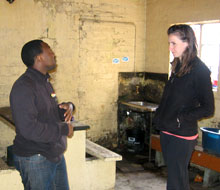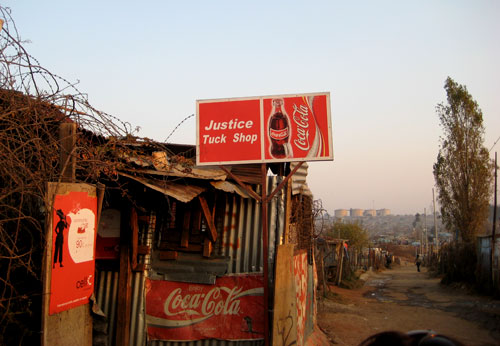Urban LandMark, Pretoria, South Africa

Laura Tausky (right) with volunteer on a tour of a work hostel in Langa township, Cape Town. |
A few days after my arrival in South Africa, someone described the country to me as a "land of contrasts." Although they were referring specifically to the physical landscape, I have since come to realize that the phrase applies equally to other social, political and economic spheres of life in South Africa. I spent my first few weeks in South Africa traveling around and experienced its geographic diversity: the unique mountain vistas of Cape Town, the semi-arid vastness of the karroo, the cosmopolitan energy of Johannesburg and the subdued animal rein in Kruger National Park. Through these travels, I also got to see the socioeconomic contrasts of the country. The apartheid legacy has etched itself onto the landscape of South Africa and the disparities in wealth, as well as the lack of spatial integration, remain prominent features. This entrenched cycle of poverty has, to some degree, tempered the optimism surrounding the new South African republic. It is also the underlying source of high levels of crime throughout the country and caused a spell of xenophobic attacks that occurred right before my arrival.
Public opinion in South Africa varies as much as its landscape. Speaking to ten different South Africans about the state of affairs will usually reveal ten dramatically different visions of the country. Within a week of my arrival, I had met an Afrikaner who expressed his nostalgia for the apartheid system, another white South African who was in the process of immigrating to Mauritius because he was so despondent about the state of crime in the country, a South African with an African background who took me to see Freedom Park in Pretoria and emphasized how it is the only place in the country where all South Africans are equally valued and commemorated and another who painted a picture of the vibrancy of life in Jo'burg and elaborated on how the country was just building up its democratic momentum.
It is within this distinct and divided context that I began my internship. Years of government intervention under the apartheid regime created an urban land distribution pattern that deprived non-white South Africans of adequate housing and infrastructure. Those who moved to the city were forced to live in designated 'township' areas at the margins of the city. The legal and regulatory framework reflected this racial stratification and left a legacy of poorly serviced townships in peripheral locations (in Cape Town, golf courses were used as a buffer between the city and the townships). Ironically, the legislation relating to township establishment remains part of the present land development protocol despite the fact that it was designed to sustain a system of segregation, in stark contrast to the current government imperative to promote integration. It should also be noted that the new South African Constitution is unique in that it actually confers a positive right to adequate housing.
In the contemporary urban environment, there are no legal barriers that prevent the poor from accessing land in the city but significant market constraints remain. The availability of land and housing is limited and although the government has an elaborate program to provide subsidized housing, the demand is hugely disproportionate to the supply and the creation of the subsidized housing stock cannot keep up with rates of urbanization. As well, the cost of servicing the houses often remains beyond the means of many South African households and the housing projects are regularly established on poorly located land from which it is difficult to access economic opportunities. A recent study commissioned by Urban LandMark revealed that up to 80% of South African households cannot afford to access the formal land market within urban centres. As a result, people are forced to resort to alternative arrangements. Informal settlements have 'piggybacked' on township areas, and backyard shacks and informal rental transactions remain common features of South African cities.
Urban LandMark has launched a new initiative to promote security of tenure and the 'right to the city.' Current research is focused on the gap between the formal urban land market and informal arrangements that are characterized by uncertainty and a lack of enforceable rights. The work builds on local practices that exist within informal settlements in order to carve out alternative channels of access to land and housing. The emphasis is not on formal title, since this remains beyond the reach of most urban residents, but rather on the alternate avenues that can be used to provide meaningful content to the right to adequate housing and to advance the goals of urban integration through the establishment of incremental property rights. As well, the focus shifts from the function of land as an investment for asset accretion (which requires full property title) toward its value as a livelihood base. To date, my role at Urban LandMark has been to work within this niche and research what intermediary forms of tenure exist and how these can be incorporated into a policy that distributes security of tenure to those without access to the formal land market.
As a result of my work on land and housing issues, I am realizing that the contrasts that are so ubiquitous within South Africa present a range of possibility for navigating the space that exists between black and white definitions. "Change" is the operative word that catches everyone's tongue and unites opinion on what is happening in the 'new South Africa.' It is an engaging climate in which to work particularly since, as my boss at Urban LandMark put it, South Africa "has quite an incredible story."

"Justice" tuck shop, in an informal settlement in Soweto, Johannesburg


